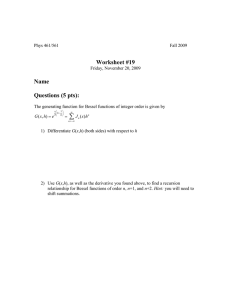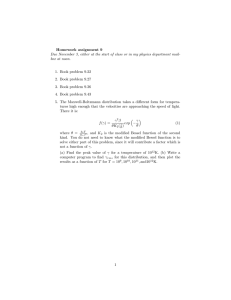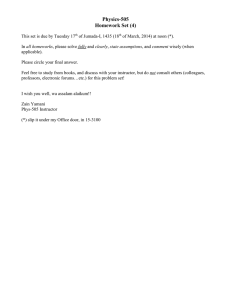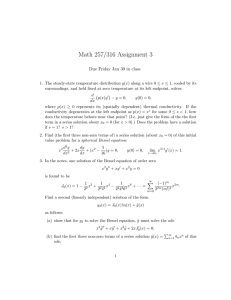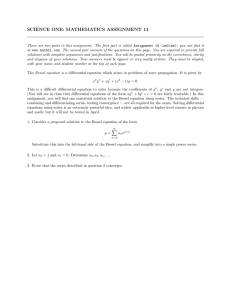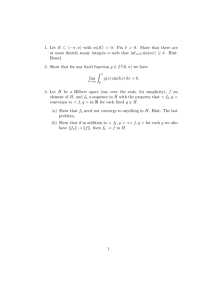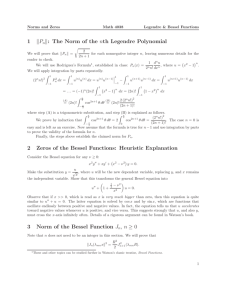PHYSICS 116C Homework 3 Due in class, Thursday October 17
advertisement
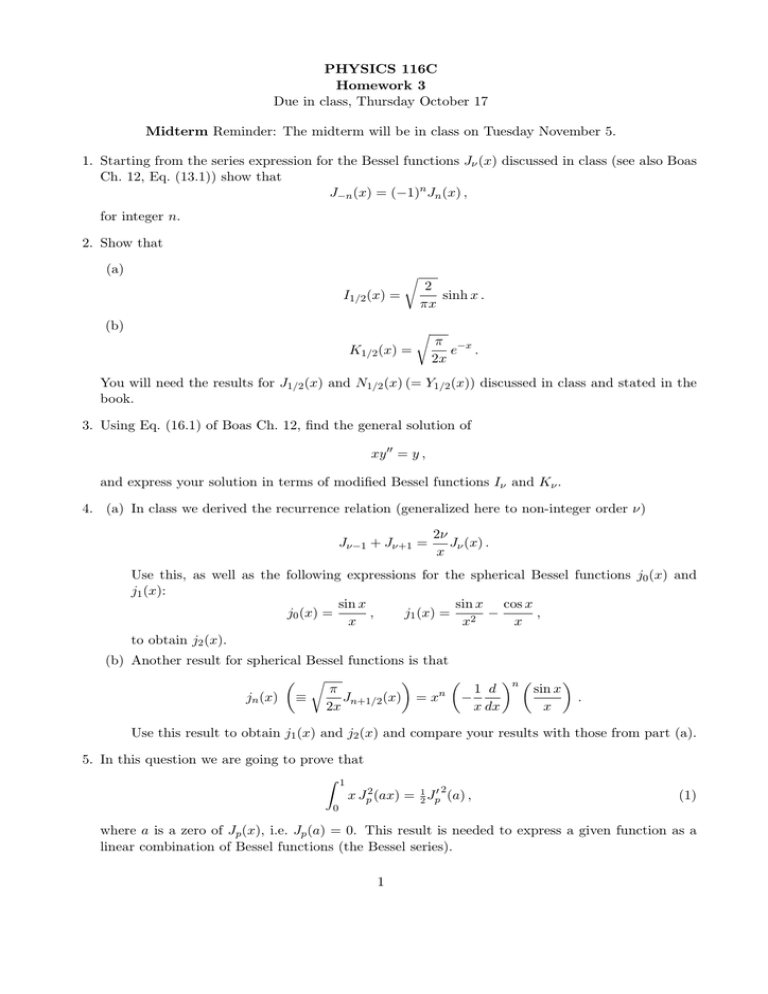
PHYSICS 116C Homework 3 Due in class, Thursday October 17 Midterm Reminder: The midterm will be in class on Tuesday November 5. 1. Starting from the series expression for the Bessel functions Jν (x) discussed in class (see also Boas Ch. 12, Eq. (13.1)) show that J−n (x) = (−1)n Jn (x) , for integer n. 2. Show that (a) I1/2 (x) = r 2 sinh x . πx (b) K1/2 (x) = r π −x e . 2x You will need the results for J1/2 (x) and N1/2 (x) (= Y1/2 (x)) discussed in class and stated in the book. 3. Using Eq. (16.1) of Boas Ch. 12, find the general solution of xy ′′ = y , and express your solution in terms of modified Bessel functions Iν and Kν . 4. (a) In class we derived the recurrence relation (generalized here to non-integer order ν) Jν−1 + Jν+1 = 2ν Jν (x) . x Use this, as well as the following expressions for the spherical Bessel functions j0 (x) and j1 (x): sin x sin x cos x j0 (x) = , j1 (x) = 2 − , x x x to obtain j2 (x). (b) Another result for spherical Bessel functions is that r 1 d n sin x π n − J (x) = x . jn (x) ≡ 2x n+1/2 x dx x Use this result to obtain j1 (x) and j2 (x) and compare your results with those from part (a). 5. In this question we are going to prove that Z 1 2 x Jp2 (ax) = 21 Jp′ (a) , (1) 0 where a is a zero of Jp (x), i.e. Jp (a) = 0. This result is needed to express a given function as a linear combination of Bessel functions (the Bessel series). 1 In the handout on orthogonality of Bessel functions, and in class, we showed that Z 1 ′ ′ 1 2 2 t v u − t u v 0 + (a − b ) t u(t) v(t) dt = 0 , (2) 0 where u(t) = Jp (at) and v(t) = Jp (bt). At no point in the derivation of Eq. (2) did we assume that a and b are zeros. Here we will take a to be a zero of the Bessel function but b not. Show that Eq. (2) gives Z 1 Jp (b) a Jp′ (a) . (3) t u(t) v(t) dt = b2 − a 2 0 Now we vary b, letting it approach a. Both numerator and denominator of the RHS of Eq. (3) are zero in this limit, and the ratio is obtained from L’Hopital’s rule (take the ratio of derivatives). Hence show that Z 1 lim b→a 0 x Jp (ax)Jp (bx) = 1 2 2 Jp′ (a) (4) which is just Eq. (1). 6. (a) Equation (9) of the handout on “The differential equation satisfied by Bessel functions” states J0′ (x) = −J1 (x). Use this to show that Z ∞ J1 (x) dx = 1. 0 (b) Equation (8) of the same handout states that Jn−1 (x) − Jn+1 (x) = 2Jn′ (x). Use this equation to show that Z ∞ Z ∞ Z ∞ J2n+1 (x) dx. J3 (x) dx = · · · = J1 (x) dx = 0 0 0 (c) Similarly show that Z ∞ J0 (x) dx = 0 Z ∞ J2 (x) dx = · · · = 0 Z ∞ J2n (x) dx. 0 R∞ (d) It can also be shown that 0 J0 (x) dx = 1. This result is trivially obtained from the k = 0 Fourier transform of J0 (x) which in turn can easily be obtained from the (given) answer to the final part of Qu. 5 in homework set 2. Here we will just assume the result. With this assumption, and the results of the earlier parts of this question, show that Z ∞ Jn (x) dx = 1 for all non-negative integral n, 0 a quite striking result. Note: A similar looking, and also surprising, result is that ∞ X Jn (x) = 1 n=−∞ for any x, which follows by setting t = 1 in the generating function, Eq. (1) in the handout “The differential equation satisfied by Bessel functions”. 2
